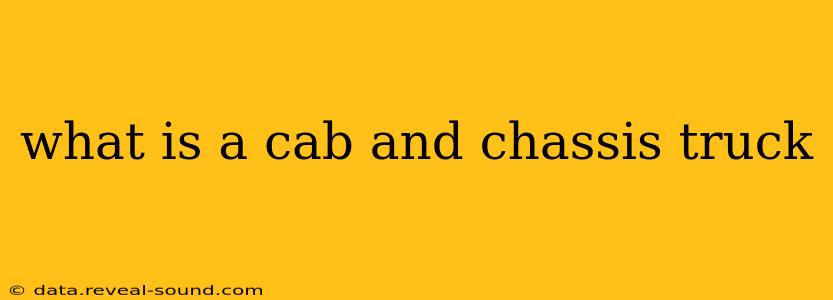What is a Cab and Chassis Truck?
A cab and chassis truck is essentially a vehicle's foundation – the engine, chassis (the frame), and cab (the driver's compartment) – without a body. Think of it as a blank canvas, ready to be customized for specific purposes. Unlike a complete pickup truck or delivery van that comes with a pre-built cargo area or bed, a cab and chassis gives you the flexibility to choose and install a body that perfectly fits your needs. This makes them incredibly versatile and popular for various commercial applications.
This unique design offers several advantages, leading to its widespread use in diverse industries. Let's dive deeper into the specifics.
What are the advantages of a cab and chassis truck?
The key advantage of a cab and chassis truck lies in its customizability. This allows businesses to tailor the vehicle to precisely match their operational requirements. Here's a breakdown:
-
Specialized Body Options: The lack of a pre-built body means you can choose from a vast array of body types. Need a refrigerated unit for perishable goods? A flatbed for hauling materials? A dump body for construction work? The possibilities are practically limitless. You can select a body perfectly designed for your cargo and work style.
-
Increased Payload Capacity: Since there's no pre-existing body adding weight, cab and chassis trucks generally offer higher payload capacities. This means they can carry more weight, leading to increased efficiency and potentially fewer trips.
-
Enhanced Durability and Longevity: By selecting a body specifically for your application, you can optimize for durability. A robust body designed for heavy-duty tasks will enhance the overall lifespan of your truck compared to a generic pre-built option that might not withstand the same level of wear and tear.
What are some common uses for cab and chassis trucks?
The versatility of cab and chassis trucks leads to their widespread use across various sectors:
- Construction: Hauling building materials, equipment, and debris. Dump bodies are particularly common in this industry.
- Delivery Services: Businesses can opt for specialized bodies like enclosed vans or refrigerated units depending on what they need to transport.
- Waste Management: Garbage trucks, recycling trucks, and other waste management vehicles often utilize cab and chassis setups.
- Emergency Services: Ambulances, fire trucks, and other emergency response vehicles are frequently built on cab and chassis configurations.
- Agriculture: Transporting crops, equipment, and livestock.
What is the difference between a cab and chassis and a pickup truck?
The main difference lies in the body. A pickup truck comes with a factory-installed bed, typically an open cargo area. A cab and chassis, on the other hand, only includes the cab and chassis, requiring a separate body to be fitted. This customization is the primary differentiator.
How much does a cab and chassis truck cost?
The cost varies greatly depending on the brand, model, engine size, and any added features. Generally speaking, they are more expensive than a comparable pickup truck initially, because you have the cost of the chassis plus the separate cost and installation of the body. However, the long-term cost effectiveness can be significant due to increased longevity and better suitability for intended tasks.
Are cab and chassis trucks right for me?
Whether a cab and chassis truck is right for you depends entirely on your specific needs. If you require maximum flexibility and customization to optimize your vehicle for a specialized purpose and prioritize payload capacity, then a cab and chassis is likely the best choice. However, if you require a ready-to-use vehicle for general purposes and prioritize cost-effectiveness at the initial purchase stage, a standard pickup truck may be more suitable. Carefully consider your operational requirements and budget before making a decision.
